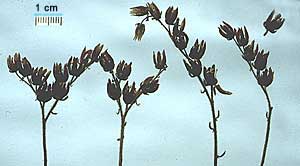Notes
ECHEVERIA SETOSA
Mexican Firecracker
Mexican Firecracker
Popular also as "Firecracker Plant," Echeveria setosa stands well up in the list of my greenhouse plants which quickly attract the attention of visitors. When in bloom, about late April to early July, its striking, bright red and yellow flowers are displayed in erect, arched helicoid cymes from each dark rosette.
 When a mature clump of perhaps a dozen or more rosettes has formed, the sight of it in bloom easily elicits thoughts of fireworks. At other seasons though, it is the neat dark-green, white-bristled leaves, in dense mounds of globose rosettes which stand out very distinctly, practically inviting favourable comment.
When a mature clump of perhaps a dozen or more rosettes has formed, the sight of it in bloom easily elicits thoughts of fireworks. At other seasons though, it is the neat dark-green, white-bristled leaves, in dense mounds of globose rosettes which stand out very distinctly, practically inviting favourable comment.The photo dates from April, 1993, when this particular plant first bloomed for me (The cymes are not fully developed). From a small, 4cm offset, it had grown in two years to 8cm and produced these cymes and two more before the end of its season in late May. This plant was one of my ramets of a clone descended from a single rosette, probably also a ramet, that I had obtained some years before. It is important to state, then, that all my E.setosa plants are ramets which, considered all together, are a single genetic individual in many parts, called a clone, descended asexually, from an original, particularly small seedling plant, probably a normal variation, possibly a ",sport", called the ortet. This same clone is still active in the Dalhousie University's Biology Greenhouse and it produced nearly three dozen inflorescences in May and June 2002. It is in three pots of several plants each, all quite leggy just now, so the rosettes will be cut, rerooted and potted up for a fresh start.
Echeveria setosa is native to the mountains of Puebla State, Mexico. Its main dislikes appear to be cold below 7oC (45oF) and moisture on its leaves, especially near the stem, causing rot. Several references I have consulted state that it produces its offsets "usually when 15cm (6in.) diameter" but this rosette (top photo) at its final size, 8cm (3in.) in diameter, made 8 or 9 offsets shortly afterward and all my other Mexican Firecrackers have (and had) done about the same at that size. Only the leaf length, and hence the rosette diameter, varies from Jacobsen's description and the cymes reach from about 15cm (6") to 20cm (8") tall, Jacobsen's minimum, each with about 6 to 9 florets. Branches, if any, seem to develop 4 to 6 florets each.
 The offsets are each perfect miniatures of the main rosette, all are perfectly well-proportioned and they remain so until they reach full size. In larger groups of rosettes, about 40% of the inflorescences are branched (photo at right) but each branches only once, as another helicoid cyme, and the branch always (at least in this clone) appears from the axil of about the ninth to the 15th bract from the axis' origin. Each rosette eventually throws out 1 to (usually) 4 cymes which may all be of one kind, or of a mixture of both branched and unbranched cymes.
The offsets are each perfect miniatures of the main rosette, all are perfectly well-proportioned and they remain so until they reach full size. In larger groups of rosettes, about 40% of the inflorescences are branched (photo at right) but each branches only once, as another helicoid cyme, and the branch always (at least in this clone) appears from the axil of about the ninth to the 15th bract from the axis' origin. Each rosette eventually throws out 1 to (usually) 4 cymes which may all be of one kind, or of a mixture of both branched and unbranched cymes. One measure of the importance and popularity of E.setosa is that it and many of its cultivars are described in some detail not only in many books dedicated to succulents but in other important general works such as Bailey's Hortus III and the Royal Horticultural Society's Gardener's Encyclopaedia.
Mexican Firecracker is also popular for hybridization. The cross E.harmsii x E.setosa, for example, produced Echeveria 'Set-Oliver', popular in Britain. Other crosses elsewhere resulted in Echeveria 'Herzblut' in Germany and Echeveria 'Doris Taylor' in California, to name but a few. Crested clones are also known and highly valued by many collectors.
Propagation is quite easy from seed or from cuttings, the latter either from individual leaves or from offset rosettes. I have not tried seeds, but from very small rosettes one can expect flowers in about 2 years or less, while from leaves it can take up to 3 years, depending upon the cultural attention they are given. My tendency has been to be somewhat harsh in providing just enough low-nitrogen, high-potash fertilizers, enough but minimal irrigation in the growing season and the coolest (7oC to 10oC) but safe treatment possible in the wintertime. I believe that this combination, with a few other factors, all tending to emphasize moderate stress on the plants, results in sturdier, more compact, more floriferous plants and better flower colour saturation but it also calls for more patience because growth is appreciably slower.
(The original version of this note appeared in The Amateurs' Digest Vol.10, Issue 3, September, 1998. Click on "Useful Links" on the Home Page for the address.)
| Paul J. Brunelle September 12, 2002 |